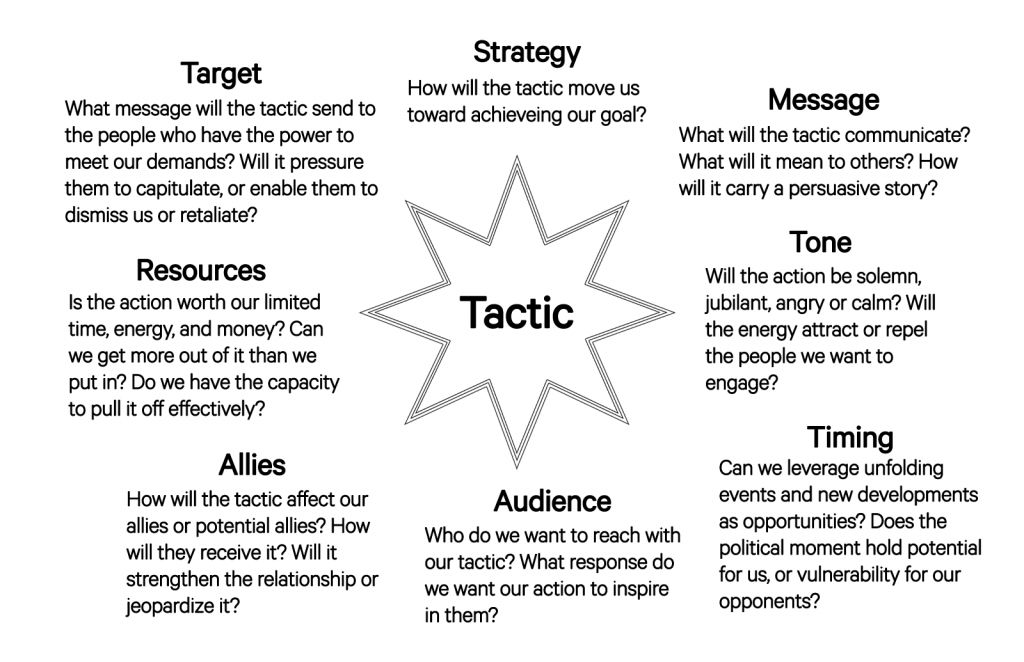Collective Nonviolent Action Study Materials
Ted Talk on nonviolence literacy by Alia Braley
Please see this Ted Talk by Alia Braley, nonviolence educator, on strengthening our collective abilities to deliver nonviolent direct action and improve our nonviolence literacy.
A Force More Powerful – film

Please see A Force More Powerful, a documentary series on one of the 20th century’s most important and least-known stories: how nonviolent power overcame oppression and authoritarian rule. It includes six cases of movements, and each case is approximately 30 minutes long.
Collective Nonviolent Action Study Agenda
This is an agenda for a longer training, ‘First Steps’, done 7/26 and 8/23. Please see the FB Livestream recording from 8/23 here.
Collective Action is #PeoplePower. We use our solidarity as a tool to strengthen us – that, and the clear Justice of our campaigns, result in our having and/or being a Force More Powerful.
De-escalation is important, achieved in large part by the twin elements of rejecting the violence or bad deeds of a person while showing the utmost caring and regard for him/her/them as an individual; in other words, Unarmed Truth and Unconditional Love.
1 Peace Agreement
2 Underused Peace Tool: Song! Sing – Everybody’s got a right to live!
3 Brief Go ‘Round – intros
3.1 Collective Action
• Nonviolence literacy – See Ted Talk by Alia Braley above. (“How to win vs ISIS”)
• A Force More Powerful: film (see above) – talks about:
o India ejecting the British – Gandhi’s Nonviolence, Salt March
o Danish in World War II – all wore Star of David to support Jews
o US Civil Rights Movement – Rev Dr King and all
o Anti-Apartheid in South Africa
o Polish Solidarnosc
3.2 Territory – In pairs. Directions to be announced.
3.3 Dr. Martin Luther King Jr. – Six Principles of Kingian Nonviolence
o Nonviolence is a way of life for courageous people.
o Nonviolence seeks to win friendship and understanding
o Nonviolence seeks to defeat injustice not people
o Nonviolence holds that suffering can educate and transform.
o Nonviolence chooses love instead of hate.
o Nonviolence believes that the universe is on the side of justice.
3.4 “On Revolution and Equilibrium”
We can put more pressure on the antagonist for whom we show human concern…We put upon him two pressures – the pressure of our defiance of him and the pressure of our respect for his life – and it happens that in combination these two pressures are uniquely effective.” – Barbara Deming
4 Small Group Discussion
What is your rally/protest hot button?
5 Know Your Rights –Daire Brian Irwin, Esq.; John Curr, NYCLU
6 SAFETY – Be Prepared – Nick et al from Buffalo Action Medics
(Info on protective gear, tear gas, sound cannons, etc)
7. Questions not yet asked, and “I liked/ I learned/ I wish…”
8. Announcements
9. Closing
Tactic Star (Planning tool)

Exercises
Focus areas: Aggressive (counter-)protesters, verbal aggression, physical aggression, protecting others, etc. Police: Verbal aggression, physical aggression, protecting others, arrest sheet, etc. Problem Solving/Brainstorming/Roleplays – some possibilities:
Parallel Lines/Hassel Lines: This activity will focus on boundaries, persuasion, and utilization of nonviolent direct action. The person across from them is their focus. However, there are two roles in this exercise: everyone in one line has the same role and the people opposite from them have another role. The facilitator explains the roles for each side, describes the conflict, and who will start it. Encourage creativity and spontaneity. (It may be helpful to brief the two sides separately)
What did people do? How did they feel? What did you notice about your body language, voice, tone, or other ways your body responds to conflict? What ways did you find to solve or deal with the conflict?
Amoeba: Practice role play of a conflict. Advocates will absorb their fellow advocate by inserting themselves as a connected circle. One by one, each person shall build a circle around the person. This should be practiced several times.
Surround “U”: Surround (“U’) and move perpetrator away: With several people, step between the attacker and the demonstrator, form a U shape around the perpetrator, and move him or her away. Don’t completely surround the attacker; make sure to leave him or her an ‘out’. Talk with the attacker reassuringly as you do this.
Please click the link for more information and training through VCNV.
